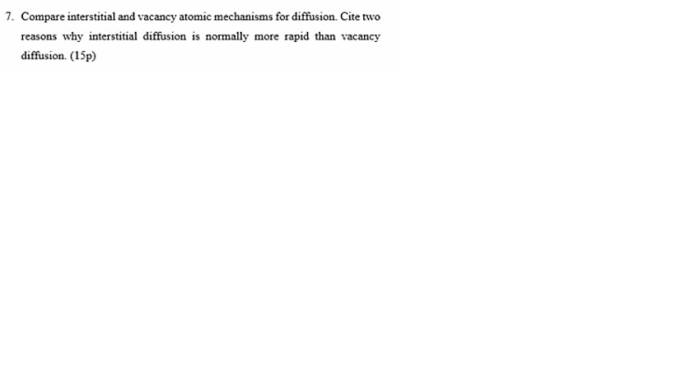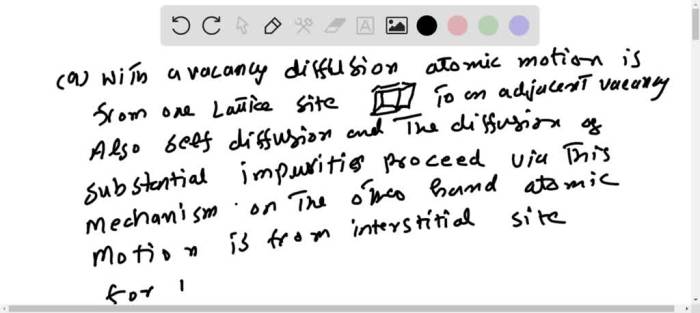Compare interstitial and vacancy atomic mechanisms for diffusion – The comparison of interstitial and vacancy atomic mechanisms for diffusion is a topic of great importance in materials science. Diffusion is the movement of atoms or molecules from one location to another, and it is a fundamental process in many physical and chemical phenomena.
The two main atomic mechanisms for diffusion are interstitial diffusion and vacancy diffusion. Interstitial diffusion occurs when an atom moves into an interstitial site, which is a space between atoms in a crystal lattice. Vacancy diffusion occurs when an atom moves into a vacancy, which is an empty lattice site.
The choice of which atomic mechanism is dominant in a particular material depends on several factors, including the size of the diffusing atom, the temperature, and the crystal structure of the material. In this paper, we will compare and contrast interstitial and vacancy atomic mechanisms for diffusion, and we will discuss the factors that affect the choice of mechanism.
Interstitial Mechanism

Interstitial diffusion occurs when an atom moves from its normal lattice site to an interstitial site, which is a space between the lattice sites. This mechanism is typically observed in materials with open crystal structures, such as body-centered cubic (BCC) and face-centered cubic (FCC) metals.
The activation energy for interstitial diffusion is generally lower than that for vacancy diffusion because it does not require the creation of a vacancy.
Conditions Favoring Interstitial Diffusion, Compare interstitial and vacancy atomic mechanisms for diffusion
Interstitial diffusion is favored in the following conditions:
- High temperatures: At high temperatures, the atoms have more energy and are more likely to move into interstitial sites.
- Small interstitial atoms: Atoms that are small relative to the lattice sites are more likely to fit into interstitial sites.
- Open crystal structures: BCC and FCC metals have open crystal structures that provide more interstitial sites for atoms to occupy.
Examples of Materials Exhibiting Interstitial Diffusion
Some examples of materials that exhibit interstitial diffusion include:
- Hydrogen in metals: Hydrogen atoms are small and can easily fit into interstitial sites in metals.
- Carbon in steel: Carbon atoms can occupy interstitial sites in the BCC structure of steel.
- Nitrogen in titanium: Nitrogen atoms can diffuse interstitially in the HCP structure of titanium.
FAQs: Compare Interstitial And Vacancy Atomic Mechanisms For Diffusion
What is the difference between interstitial and vacancy diffusion?
Interstitial diffusion occurs when an atom moves into an interstitial site, which is a space between atoms in a crystal lattice. Vacancy diffusion occurs when an atom moves into a vacancy, which is an empty lattice site.
Which atomic mechanism is dominant in a particular material?
The choice of which atomic mechanism is dominant in a particular material depends on several factors, including the size of the diffusing atom, the temperature, and the crystal structure of the material.
What are the advantages and disadvantages of each atomic mechanism?
Interstitial diffusion is typically faster than vacancy diffusion, but it can also lead to the formation of defects in the crystal lattice. Vacancy diffusion is slower than interstitial diffusion, but it does not lead to the formation of defects.


